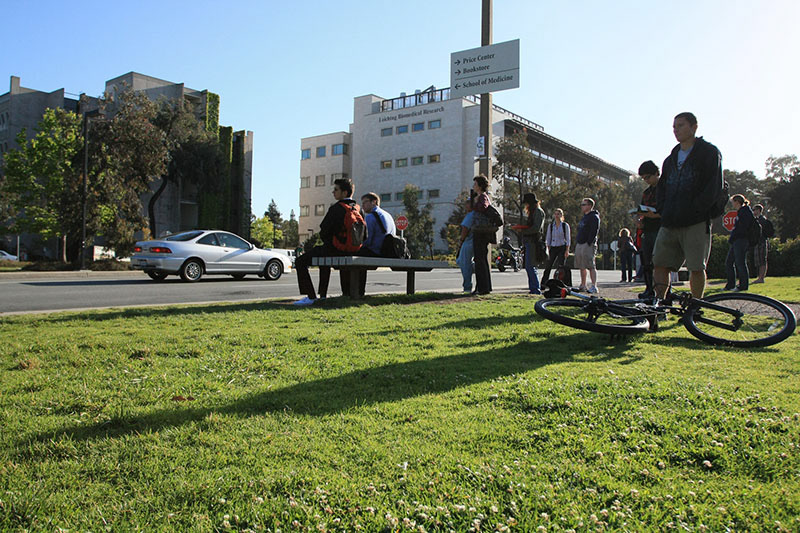A study in cognitive ethnography.

Frame 1.

Frame 2.
"activity that is shaped by the social and cultural settings as well as by the transportation infrastructure"

Frame 3. [an illustration]
Navigating through time and space is an everyday activity that requires individuals to interact with each other and with their surrounding cultural and material environment. The following is an observation and analysis of individuals waiting for the bus in a university setting. Photographs of this activity can be described in terms of what the bodies are doing.
Frame 1 consists of a congregation of bodies. However, while the individuals within the group are close to one another in proximity, their head and gaze is oriented toward the street. Every body within the frame appears static due to the placement and orientation of appendages. Legs are fairly parallel to one another and arms are retracted to folding position or are hidden away in clothing pockets. Many individuals have shifted their weight onto one leg, seen by a protruding hip. Bodies are positioned on the grass, all the way up to but not over the sidewalk.
The engaging of body parts with others or objects within the physical world (co-articulation) take place. One individual is oriented in relation to a bicycle; the bike is placed on the ground in a non-functional orientation. The group of standing, static bodies appear to be dispersed behind two seated individuals. They have oriented themselves in a sitting position upon a on an object within the environment: a bench. While the couple of sitting bodies are oriented to better fit with this object, all other bodies remain standing. This bench is placed at the front of the inhabited area, right at the edge of the sidewalk that divides grass and pavement. Also, bench placement is directly underneath a sign marking the buses that stop at that particular location. The bodies occupy the grass area, while motorized vehicles are seen to follow the trajectory of the road.
In frame 2 the bodies appear to be captured in mid motion. The parallel positioning of legs seen in frame one has shifted, resulting in leg distance that creates an apparent angle. With feet no longer grounded as knees bend and torso weight shifts forward, the bodies exhibit a synchronized trajectory towards the street. All bodies exhibit this relative positioning in unison, as they are oriented toward the bus that has newly appeared in the frame.
To show configural change, the addition of frame 3 has been added since it highlights patterns of movement over time.
Transparent overlays of images seen in frame 3 highlights movement-- the more opaque figures are seen to have remained stationary over multiple frames. The opaque bodies indicate a period of waiting, just as transparent figures reveal a body’s brief encounter with that space. Body positioning relative to surroundings is central to revealing the activity’s purpose.
Orientations of body sensors are cues of information-seeking behavior. With heads turned toward the street, gaze is directed toward the information of approaching vehicles. The bicycle’s orientation in frames 1 and 3 is indicative of a waiting period. Placing the object on the ground provides a better fit, since it reduces the cognitive weight of the waiting activity. Free of the bicycle, the individual can direct more attention toward information relative to his goal of identifying the arrival of the bus. Also, shifting body weight onto one leg is conducive to easing the body tension that often accompanies long periods of inactivity. Configuring the body to fit this particular situation makes the (in)activity of waiting more affordable.
Such “dialectical processes of problem solving make…monitoring possible [with] juxtaposition of problem, solution, and checking activities” (Lave, 92). Although the individuals in frame one appear passive, their body and head orientation allows attention to be directed toward relevant events. Once the bus comes, the large vehicle is salient and the problem of waiting for transportation is solved. In addition to continuous checking, peripheral cues such as mass group movement toward the street can indicate arrival of the bus. This interaction creates a dialect between setting and activity.
Lack of direct social interaction indicates this area is not used solely for the purpose of socializing, rather it is seen to be a place that has meaning, specifically to enter and exit a vehicle (Hutchins, UCSD talk, 2011). This group-waiting activity can be seen as a “socially situated phenomena”, activity that is shaped by the social and cultural settings as well as by the transportation infrastructure. “The ability to build and interpret material cognitive artifacts, [such as the bus signs, bench, etc.] are embedded within a web of [social] discourse” (Goodwin, 29). With close observation of daily activities, we are able to explore underlying cognitive processes as well as those that take place outside the physical body.
WORKS CITED
Goodwin, Charles (1994). "Professional Vision." American Anthropologist 96(3): 606-633.
Hutchins, Edwin. "Discursive Practices." UCSD. La Jolla. 20 Jan. 2011. Lecture.
Johnson, Christine M. "Observing Cognitive Complexity in Primates and Cetaceans." International Journal of
Comparative Psychology 23 (2010): 587-624.
Johnson, Christine M. "Observing Complexity: Nonhuman Behavior." UCSD. La Jolla. 13 Jan. 2011. Lecture.
Lave, J., et. al, “The Diaclectic of Arithmetic in Grocery Shopping,” Everyday Cognition. Harvard University Press, 1984: 67-94.
Williams, R. F. (2006). Using cognitive ethnography to study instruction. Proceedings of the 7th International Conference of the Learning Sciences. Mahwah, NJ: Lawrence Erlbaum Associates.

